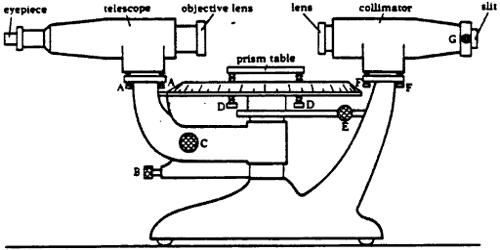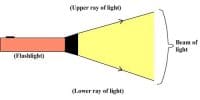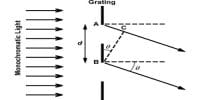The initial adjustment of the spectrometer consists of adjustments to the telescope and the collimator. First, adjust the eyepiece of the telescope so that the crosshairs are sharply focused. Next, swing the telescope to one side and point it at some distant object. Next, place a light in front of the entrance slit of the collimator. View the slit through the telescope. Adjust the collimator lens until the image of the slit is in the plane of the crosshairs. You should use parallax focusing to accomplish this.
The following adjustments must be made before doing the experiment with spectrometer:
(i) Adjustment of the eyepiece
The telescope is turned towards an illuminated surface and the eyepiece is moved to and fro until the cross wires are clearly seen. It will then be focused on the crosshairs of the telescope by the objective lens of the telescope. This image of the slit can then be viewed through the eyepiece.
(ii) Adjustment of the telescope
The telescope is adjusted to receive parallel rays by turning it towards a distant object and adjusting the distance between the objective lens and the eyepiece to get a clear image on the cross wire.
Bring the air bubble of the spirit level halfway towards the center by first turning the two base leveling screws and then turning the telescope leveling screw. Now rotate the telescope through 180° and adjust the base and telescope leveling screws. Repeat the operations several times so that the bubble remains at the center for both positions of the telescope.
(iii) Adjustment of the collimator
The telescope is brought along the axial line with the collimator. The slit of the collimator is illuminated by a source of light. The distance between the slit and the lens of the collimator is adjusted until a clear image of the slit is seen at the cross wires of the telescope. Since the telescope is already adjusted for parallel rays. a well-defined image of the slit can be formed, only when the light rays emerging from the collimator are parallel.
Remove the spirit level from the telescope. Place it on the collimator along its length. Bring the air bubble of the spirit level at the center by adjusting the collimator leveling screw provided below the collimator. This makes the axis of the collimator horizontal.
(iv) Leveling the prism table
The prism table is adjusted or leveled to be in a horizontal position by means of leveling screws and a spirit level.
Bring the air bubble of the spirit level at the center by turning these two screws in the opposite directions. Now place the spirit level perpendicular to the line joining the two screws and bring the bubble at the center by adjusting the third screw. This makes the top of the prism table horizontal.
(v) Adjusting cross wires and focusing image:
Rotate the telescope towards an illuminated background. On looking through the eye-piece, you will probably find the cross-wires appear blurred. Move the eye-piece inwards or outwards until the cross-wire appears distinct. If the image does not appear vertical, make it vertical by turning the slit in its own plane. Adjust the width of the slit to get an image of the desired intensity.
Focusing for Parallel rays by Schuster’s method: This is the best method of focusing the telescope and the collimator for parallel rays within the space available in the darkroom. In order to focus the telescope parallel light rays are required and this in turn requires a properly adjusted collimator.















